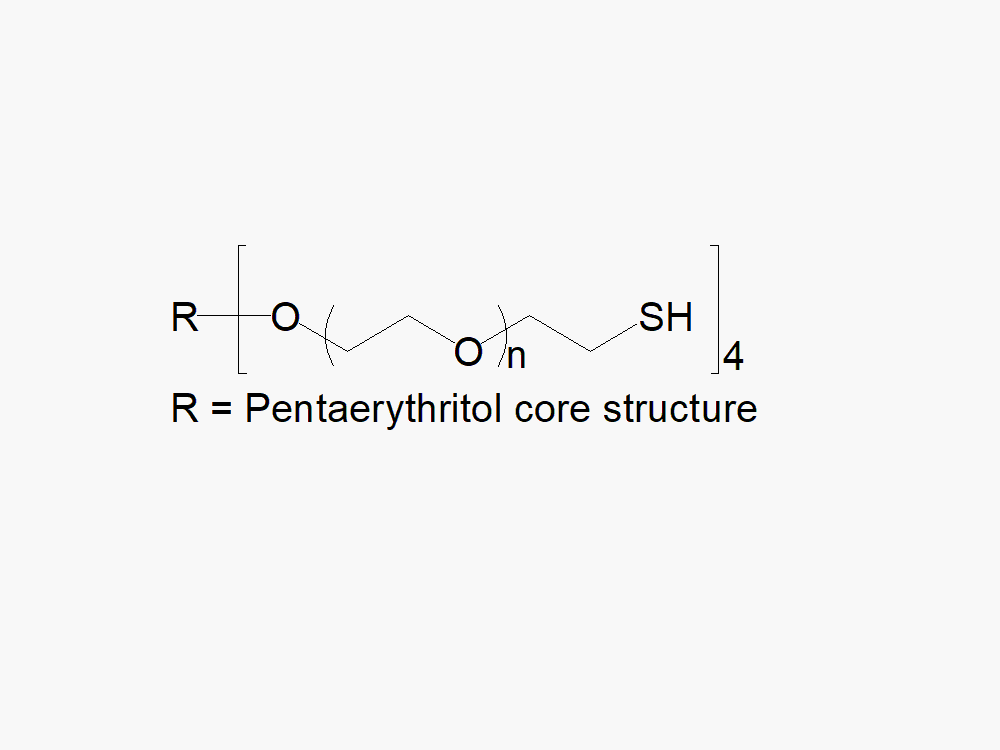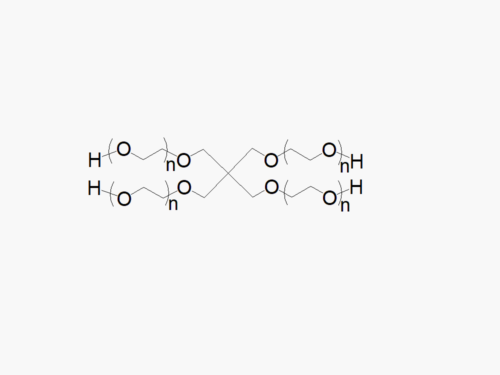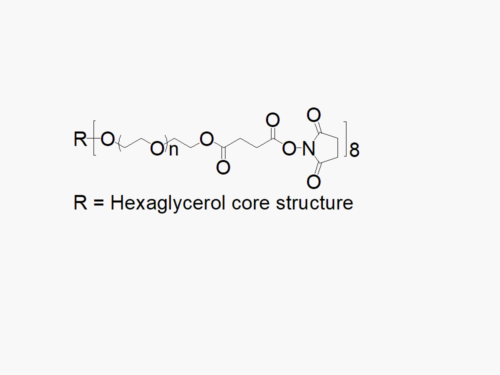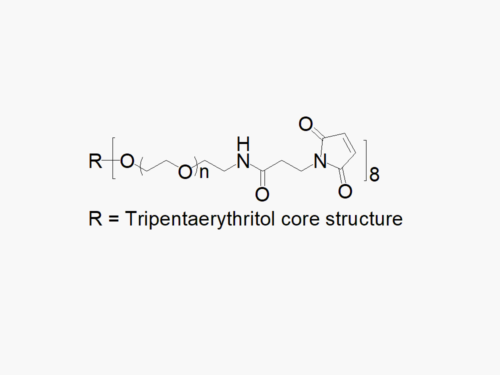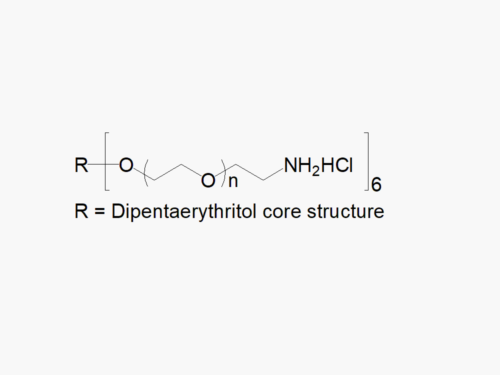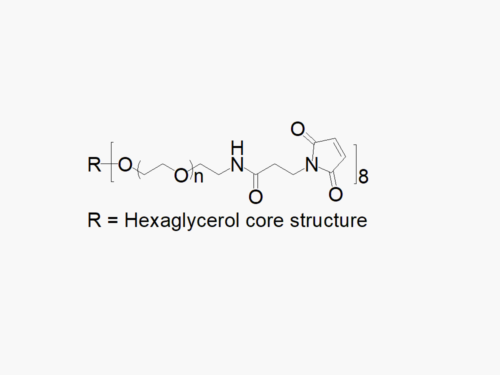PEG products with additional MW may be made to order, please contact us for details
4arm PEG Thiol
$80.00 – $640.00
Description
4arm PEG Thiol with superior quality specification of > 90% Substitution.
JenKem Technology’s 4arm PEG Thiol derivatives can be cross-linked into PEG hydrogels. PEG hydrogels have a variety of applications in medical devices and regenerative medicine, and are especially of interest for controlled release of drugs, for 2D and 3D cell culture, and for wound sealing and healing. JenKem Technology’s 4 arm PEGs are synthesized by ethoxylation of pentaerythritol. The number of ethylene oxide units in the PEG chain may not be equal for all arms. The total molecular weight reported for the JenKem multi-arm PEGs is the sum of the PEG molecular weights of each arm.
Multi-arm star PEG products with molecular weights, branching, and functional groups not listed in our online catalog may be available by custom synthesis. Please inquire at tech@jenkemusa.com about pricing and availability.
Bulk PEGs and GMP grade PEGs are made-to-order. Please contact us for bulk pricing.
Click here to download the MSDS
References:
- Genç, H., et al., Adjusting Degree of Modification and Composition of gelAGE-Based Hydrogels Improves Long-Term Survival and Function of Primary Human Fibroblasts and Endothelial Cells in 3D Cultures, Biomacromolecules, 24(3), p. 1497-1510, 2023.
- Brown, T., et al., Design and development of microformulations for rapid release of small molecules and oligonucleotides, European Journal of Pharmaceutical Sciences, 188, 2023.
- Hu, P., et al., Tumor microenvironment responsive-multifunctional nanocomposites knotted injectable hydrogels for enhanced synergistic chemodynamic and chemo-photothermal therapies, Materials & Design, V. 225, 2023.
- Du, EY, et al., A 3D bioprintable hydrogel with tuneable stiffness for exploring cells encapsulated in matrices of differing stiffnesses. bioRxiv. 2022.
- Li, J., et al., Network-Based Redox Communication Between Abiotic Interactive Materials, iScience, 2022.
- DiVito, KA, et al., Hydrodynamic Focusing-Enabled Blood Vessel Fabrication for in Vitro Modeling of Neural Surrogates. Journal of Medical and Biological Engineering. 2021, 1-4.
- Paez, JI, et al., Thiol-methylsulfone-based hydrogels for cell encapsulation: reactivity optimization of aryl-methylsulfone substrate for fine-tunable gelation rate and improved stability. Biomacromolecules. 2021.
- Dargaville, TR, et al., Poly (2-allylamidopropyl-2-oxazoline)-Based Hydrogels: From Accelerated Gelation Kinetics to In Vivo Compatibility in a Murine Subdermal Implant Model. Biomacromolecules. 2021, 22(4):1590-9.
- Aluri, KC, et al., Thiosulfinates as a Novel Class of Disulfide Cleavable Cross-Linkers for Rapid Hydrogel Synthesis. Bioconjugate Chemistry. 2021, 32(3):584-94.
- Wang, J., et al., An injectable PEG hydrogel controlling neurotrophin-3 release by affinity peptides, Journal of Controlled Release, 2021, 330, P. 575-586
- McKee, C., et al., Mesenchymal stem cells transplanted with self-assembling scaffolds differentiated to regenerate nucleus pulposus in an ex vivo model of degenerative disc disease, Applied Materials Today, 2020, 100474.
- Dos Santos, B. P., et al., Development of a cell-free and growth factor-free hydrogel capable of inducing angiogenesis and innervation after subcutaneous implantation, Acta Biomaterialia, 2019.
- Dos Santos, B.P., et al., Production, purification and characterization of an elastin-like polypeptide containing the Ile-Lys-Val-Ala-Val (IKVAV) peptide for tissue engineering applications, Journal of biotechnology, 2019, 298:35-44.
- Atallah, P., et al., Charge-tuning of glycosaminoglycan-based hydrogels to program cytokine sequestration, Faraday Discussions, 2019.
- Wang, L., et al., Dual‐Functional Dextran‐PEG Hydrogel as an Antimicrobial Biomedical Material. Macromolecular bioscience, 2018, 18(2), p.1700325.
- Hung-Yi Liu, H.-Y., et al., Biomimetic and enzyme-responsive dynamic hydrogels for studying cell-matrix interactions in pancreatic ductal adenocarcinoma, Biomaterials, 2018, V. 160, P. 24-36.
- Lewis, K.J., et al., Epithelial-mesenchymal crosstalk influences cellular behavior in a 3D alveolus-fibroblast model system, Biomaterials, 2018.
- Santa Chalarca, C.F., et al., Reactive polymer zwitterions: Sulfonium sulfonates. Journal of Polymer Science Part A: Polymer Chemistry, 2017, 55(1):83-92.
- Greene, T., et al., Comparative study of visible light polymerized gelatin hydrogels for 3D culture of hepatic progenitor cells. Journal of Applied Polymer Science, 2017, 134(11).
- Robinson, K.G., et al., Reduced Arterial Elasticity due to Surgical Skeletonization is Ameliorated by Abluminal PEG Hydrogel, Bioengineering & Translational Medicine, 2017.
- Wang, X., et al., A Polydopamine Nanoparticle Knotted Poly (ethylene glycol) Hydrogel for On-Demand Drug Delivery and Chemo-Photothermal Therapy, Chemistry of Materials, 2017.
- DiVito, K.A., et al., Microfabricated blood vessels undergo neoangiogenesis, Biomaterials, 2017.
- Scott, R.A., et al., Aortic adventitial fibroblast sensitivity to mitogen activated protein kinase inhibitors depends on substrate stiffness, Biomaterials, 2017.
- Maturavongsadit, P., et al., Influence of Cross-Linkers on the in Vitro Chondrogenesis of Mesenchymal Stem Cells in Hyaluronic Acid Hydrogels, ACS applied materials & interfaces, 2017, 9(4):3318-29.
- Zhang, K., et al., Hydrogels with a Memory: Dual-Responsive, Organometallic Poly (ionic liquid) s with Hysteretic Volume-Phase Transition, Journal of the American Chemical Society, 2017.
- DiVito, K.A., et al., Data characterizing microfabricated human blood vessels created via hydrodynamic focusing, Data in Brief, 2017, 14, P. 156-162.
- Liang, Y., et al., Controlled release of an anthrax toxin-neutralizing antibody from hydrolytically degradable polyethylene glycol hydrogels, Journal of Biomedical Materials Research Part A, 2016, 104:1, p. 113–123.
- McGann, C. L., et al., Thiol-ene Photocrosslinking of Cytocompatible Resilin-Like Polypeptide-PEG Hydrogels. Macromol. Biosci., 2016, 16: 129–138.
- Liang, Y., et al., Liposome-crosslinked hybrid hydrogels for glutathione-triggered delivery of multiple cargo molecules, Biomacromolecules, 2016.
- Mahadevaiah, S., et al., Decreasing matrix modulus of PEG hydrogels induces a vascular phenotype in human cord blood stem cells, Biomaterials, 2015, 62, P. 24-34.
- Greene, T., et al., Modular gelatin hydrogels formed by orthogonal thiol-ene photochemistry for 3D hepatocyte culture, Society for Biomaterials, 2015.
- Cambria, E., et al., Covalent Modification of Synthetic Hydrogels with Bioactive Proteins via Sortase-Mediated Ligation, Biomacromolecules, 2015, 16 (8), 2316-2326.
- Lewis, K. J. R., et al., In vitro model alveoli from photodegradable microsphere templates, Biomater. Sci., 2015, 3, 821-832.
- Greene, T., et al., Modular Cross-Linking of Gelatin-Based Thiol–Norbornene Hydrogels for in Vitro 3D Culture of Hepatocellular Carcinoma Cells, ACS Biomaterials Science & Engineering, 2015, 1 (12), 1314-1323.
- McGann, C.L., Resilin-like polypeptide-poly(ethylene gylcol) hybrid hydrogels for mechanically-demanding tissue engineering applications, 2015.
- Missirlis, D., et al., Combined Effects of PEG Hydrogel Elasticity and Cell-Adhesive Coating on Fibroblast Adhesion and Persistent Migration, Biomacromolecules, 2014, 15(1), pp 195–205.
- Daniele, M.A., et al., Interpenetrating networks based on gelatin methacrylamide and PEG formed using concurrent thiol click chemistries for hydrogel tissue engineering scaffolds. Biomaterials, 2014, 35(6): p. 1845-1856.
- Sawicki, L.A., et al., Design of thiol–ene photoclick hydrogels using facile techniques for cell culture applications, Biomater. Sci., 2014, 2, 1612-1626.
- Liang, Y., et al., Multifunctional lipid-coated polymer nanogels crosslinked by photo-triggered Michael-type addition, Polym. Chem., 2014, 5, 1728-1736.
- Kharkar, P.M., et al., Dually degradable click hydrogels for controlled degradation and protein release, J. Mater. Chem. B, 2014, 2, 5511-5521.
- Tao, Y., Evaluation of an in situ chemically crosslinked hydrogel as a long-term vitreous substitute material, Acta Biomaterialia, 2013. 9: p. 5022–5030
- Qin, H., et al., Gadolinium(III)–gold nanorods for MRI and photoacoustic imaging dual-modality detection of macrophages in atherosclerotic inflammation, Nanomedicine, 2013, 8(10), 1611–1624.
- Tong, X., et al., A new end group structure of poly(ethylene glycol) for hydrolysis-resistant biomaterials. J. Polym. Sci. A Polym. Chem., 2011, 49: 1513–1516.
Founded in 2001 by experts in PEG synthesis and PEGylation, JenKem Technology specializes exclusively in the development and manufacturing of high quality polyethylene glycol (PEG) products and derivatives, and related custom synthesis and PEGylation services. JenKem Technology is ISO 9001 and ISO 13485 certified, and adheres to ICH Q7A guidelines for GMP manufacture. The production of JenKem® PEGs is back-integrated to in-house polymerization from ethylene oxide, enabling facile traceability for regulated customers. JenKem Technology caters to the PEGylation needs of the pharmaceutical, biotechnology, medical device and diagnostics, and emerging chemical specialty markets, from laboratory scale through large commercial scale.

